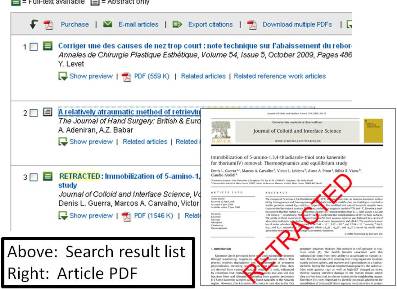Did you know that we have a subscription to The Chronicle of Higher Education online? You can use it to keep up with issues and trends in higher education. Of course, it’s not always good news.
In a recent issue, for example, I read about published papers that were retracted because authors provided fake peer reviews of their own papers. My, what a fine example of academic integrity for our students. Perhaps I should stop telling students that peer review is a quality control process.
Retractions can occur because of unintended errors, of course, but The Chronicle also published an article in April 2011 warning authors that the number of articles being retracted due to some form of misconduct seemed to be on the rise (See “Despite warnings, biomedical scholars cite hundreds of retracted papers“).
But how do you know even know that an article has been retracted?
If you are a regular reader of a journal, you should see a printed retraction notice (see an example from Journal of Chemical Physics).
The Chronicle article also mentions a Retraction Watch blog where two medical journalists are tracking scientific papers that have been retracted. But the blog isn’t an official repository of retraction notices.
I wondered how our students (and faculty) know if articles found by searching our databases are retracted. It is possible to search for the term retracted coupled with a journal name, author(s) or article title. But if that is not done, then searching for key words will find both the retraction statement and the original article. Unfortunately, they may be very far apart in the result list, and how often are researchers looking for those retraction entries? Just looking at the pdf of the original article will give no clue that it was subsequently retracted. The retraction I used above is
Retraction: “The zero kinetic energy photoelectron spectra of the propargyl radical, C3H3” [J. Chem. Phys. 112, 2575 (2000)].
Suppose I searched Academic Search Complete for JN “Journal of Chemical Physics” and “zero kinetic energy”, although in most cases our students are not limiting results to a certain journal. I get more than 150 results, and the newest ones are first. When I get to the 2009 articles I will see the retraction entry (the day I did it, it was result #12), so I should be paying attention so that when I get to the entry for the original paper I know it’s been retracted. But it doesn’t come up until pages later in the results (#77 the day I tried it).
Now, ScienceDirect (Elsevier’s database) handles it differently. In the past the retracted articles had just disappeared from the database, but for several years now the retracted articles have a watermark indicating its retraction, and a linked notice with an explanation.

One more thing to keep in mind! Just what we all needed.
